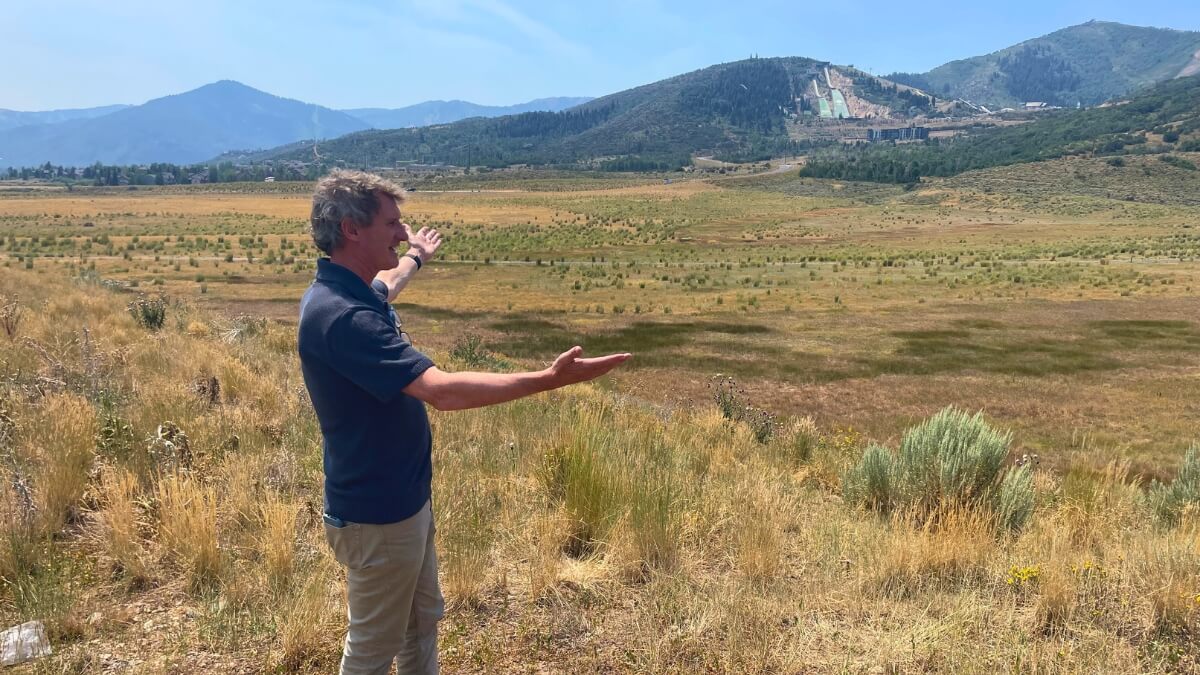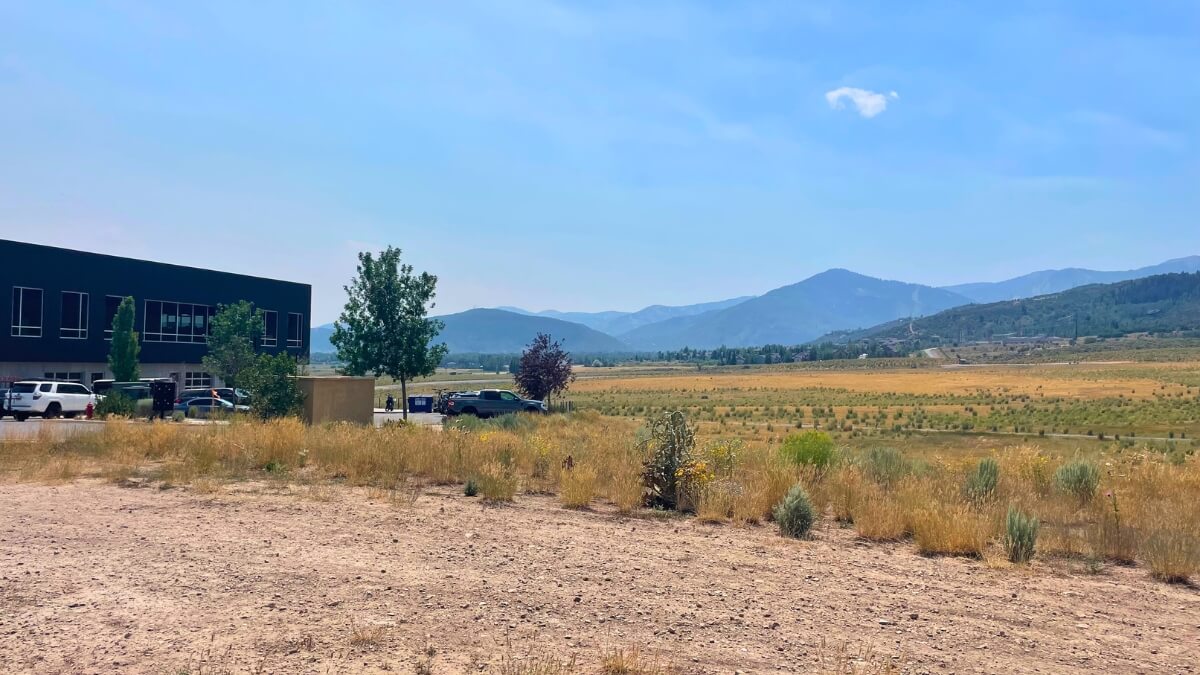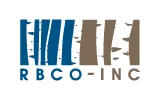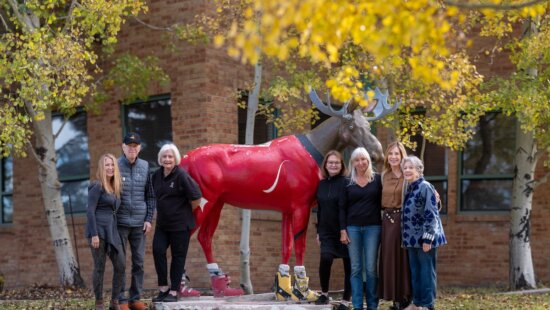Arts & Entertainment
Kimball Art Center plans major expansion in Kimball Junction move

Aldy Milliken shows the new Kimball Art Center land site. Photo: TownLift // Marina Knight
Art center secures 1.6-acre site through land deal with Dakota Pacific
PARK CITY, Utah — The Kimball Art Center has announced plans to build a new facility in Kimball Junction adjacent to the former Skullcandy property owned by Summit County, transitioning from its current location to a purpose-built space that will more than double its size.
“This new building will allow us a sustainable future and will deepen our impact to serve the community through mission-specific architecture,” said Executive Director Aldy Milliken. “We are very excited for this next chapter.”
The announcement comes days after Summit County finalized a development agreement with Dakota Pacific Real Estate to build a major housing and mixed use development in the same area. The Kimball Art Center stepped away from plans to be part of Park City’s Bonanza Park development, citing changes in that project’s direction.
“While Kimball Art Center was proud to be an early collaborator in the Bonanza Park development effort, recent shifts in the project have prompted our organization to consider options that best support our long-term goals,” Milliken explained.
From Park City Municipal’s perspective, the Kimball Art Center’s announcement marked a bittersweet moment, officials at the city said.
“We are genuinely happy for Kimball as they pursue a new chapter with a private developer — a move that brings new possibilities for their organization and the region,” a statement from PCCM said. “While we had always envisioned keeping their headquarters within the heart of Park City, they will remain an essential cultural partner and we look forward to this weekend’s Kimball Arts Festival in celebration of their continued impact.”
Land Acquisition and Strategic Partnership
The Kimball Art Center’s move is made possible through a land arrangement with developer Dakota Pacific Corp, which had allocated 1.1 acres for donation to a nonprofit organization as part of its development plans. The company designated the art center as the recipient of that land donation.
When the initial acreage proved insufficient for the organization’s requirements, Dakota Pacific sold the art center an additional half-acre at the developer’s original acquisition cost, bringing the total site to 1.6 acres. The company also provided an option on another third of an acre if it’s not needed for drainage infrastructure.
“We realized that that wasn’t quite big enough to do what we wanted to do. So we went back to them and asked if they had extra property,” Milliken explained during the site visit.

The art center’s decision will shift some of the vision for the Bonanza 5‑acre site, according to the City’s statement. Officials at the city said their offer to support the Kimball Art Center at the 5-acre site with the land valued at 2017 rates was still on the table and in the RFP to support future plans for the Kimball Art Center to build there.
The city acknowledged the move opened new opportunities, which they said could be explored in alignment with community priorities and Council direction as the project moves forward.
Vision for the New Location
The Kimball Junction site offers the organization more control over its development timeline and design while positioning it near the Utah Olympic Park with access to both local residents and tourists.
“We make world class exhibitions, but our educational programs are mostly from locals, and that’s not going to change, but we provide a great alternative for the tourist economy,” Milliken said. “If people are going to come watch an amazing event or ski or mountain bike or do whatever they do, we’re right here.”
The organization worked with cultural consultants over the past year to define what it wanted in a new space, engaging community leaders, educators and donors in the planning process.
Major Facility Expansion
The new building will more than double the art center’s current space from 9,000 square feet to between 16,000 and 20,000 square feet. The expanded facility will house exhibition galleries, educational spaces, art-making studios, offices, a cafe and retail area.
Milliken envisions taking advantage of the sloping terrain to create a unique design that could extend into the hillside or follow the natural contours of the land.
“Our exhibitions don’t actually like light, and the public obviously wants great views. You can have great views. And we can build into the hill,” Milliken said, noting that museums don’t need natural light in every gallery space.
The site’s proximity to wetlands requires a 40-foot building setback, which will influence the final architectural design. The property also offers mountain views and connection to the nearby Swaner Preserve.
Funding and County Partnerships
The art center will fund construction through fundraising efforts that include seeking grants from state, county and municipal sources. Officials are exploring partnerships with Summit County around parking arrangements for large events and other shared infrastructure needs.
“If we have a gala for 200 or 300 people, I don’t want to pay for 200 stalls,” Milliken said. “We need to sit down and clarify the parking arrangements with the county, but they’ve been really open to a dialogue with us.”
Long-term Vision
The Kimball Junction location positions the organization for significant growth over the coming decades. The site could eventually accommodate up to 30,000 square feet of building space for future expansions.
“We can’t just think about the next 10 years. We need to think about the next 100 years,” Milliken said.
Founded in 1976, the art center currently serves more than 85,000 visitors annually through exhibitions, classes and community programs. The organization has moved several times throughout its history, starting on Main Street before relocating to its current temporary space on Kearns Boulevard.
The new Kimball Junction site will be part of a broader cultural district that includes plans for a library, government buildings and transportation hub. Officials expect the location to help distribute tourist traffic more effectively while serving the organization’s educational mission for local residents.
Milliken described the vision as creating “our own local version of a 21st-century art institution,” though specific construction timelines and architectural plans are still being developed.
The organization has completed preliminary studies confirming the site can accommodate their building plans and is committed to maintaining transparency throughout the development process.



















